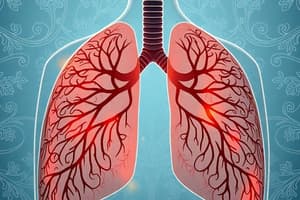Podcast
Questions and Answers
What is the compliance of the lungs as stated in the content?
What is the compliance of the lungs as stated in the content?
- 200 ml/cm H2O (correct)
- 7 ml/cm H2O
- 130 ml/cm H2O
- 65 ml/cm H2O
Which condition is NOT a cause of decreased pulmonary compliance?
Which condition is NOT a cause of decreased pulmonary compliance?
- Pulmonary fibrosis
- Pulmonary emphysema (correct)
- Pulmonary edema
- Atelectasis
What percentage of work of breathing is attributed to compliance work?
What percentage of work of breathing is attributed to compliance work?
- 21%
- 65% (correct)
- 28%
- 7%
What causes increased pulmonary compliance?
What causes increased pulmonary compliance?
What is the primary factor contributing to airway resistance?
What is the primary factor contributing to airway resistance?
Which respiratory group primarily causes expiration?
Which respiratory group primarily causes expiration?
What is the primary function of the pneumotaxic center?
What is the primary function of the pneumotaxic center?
Which type of chemoreceptors responds primarily to changes in oxygen levels?
Which type of chemoreceptors responds primarily to changes in oxygen levels?
What effect do excess carbon dioxide and hydrogen ions have on respiratory muscles?
What effect do excess carbon dioxide and hydrogen ions have on respiratory muscles?
Which of the following statements about the effect of oxygen on respiration is correct?
Which of the following statements about the effect of oxygen on respiration is correct?
Flashcards
Respiratory Center
Respiratory Center
Located in the brainstem and control breathing rate and depth.
Dorsal Respiratory Group
Dorsal Respiratory Group
A group of neurons in the medulla that primarily triggers inhalation.
Ventral Respiratory Group
Ventral Respiratory Group
A group of neurons in the medulla mainly responsible for triggering exhalation.
Central Chemoreceptors
Central Chemoreceptors
Signup and view all the flashcards
Peripheral Chemoreceptors
Peripheral Chemoreceptors
Signup and view all the flashcards
Lung compliance
Lung compliance
Signup and view all the flashcards
Lung compliance: definition
Lung compliance: definition
Signup and view all the flashcards
Lung compliance: value
Lung compliance: value
Signup and view all the flashcards
Pulmonary System compliance
Pulmonary System compliance
Signup and view all the flashcards
Compliance work (Elastic resistance)
Compliance work (Elastic resistance)
Signup and view all the flashcards
Study Notes
Compliance of Breathing
- Compliance is the change in lung volume per unit change in distending (transpulmonary) pressure.
- The formula for compliance is: C = ΔV/ΔP, where C is compliance, ΔV is the change in lung volume, and ΔP is the change in distending pressure.
- The unit for compliance is ml/cm H2O.
- Lung compliance (CL) is 200 ml/cm H2O.
- Pulmonary system compliance (the lungs and thoracic cage together) is about 130 ml/cm H2O.
Causes of Decreased Pulmonary Compliance
- Rigidity of the lungs:
- Pulmonary fibrosis (increased fibrous tissue in the lung)
- Pulmonary edema (prevents the inflation of some alveoli)
- Atelectasis (collapse of some alveoli)
- Pulmonary congestion (increased venous pressure, lung engorged with blood)
- Rigidity of the thoracic cage:
- Deformities of the vertebral column (e.g., kyphosis, scoliosis)
- Poliomyelitis (respiratory muscle disease)
- Arthritis (joints of the thoracic cage or vertebral column)
Causes of Increased Pulmonary Compliance
- COPD (Chronic Obstructive Pulmonary Disease), specifically emphysema: Loss of alveolar walls makes the lungs loose and floppy, needing less pressure difference to maintain a large volume.
- Old age: Alterations to lung elastic tissue.
Work of Breathing
- Compliance work (elastic resistance): 65%
- The work needed to stretch the elastic tissue of the lung and chest wall.
- Increases in conditions associated with decreased lung compliance.
- Tissue resistance work: 7%
- Work to overcome the viscosity of lung and chest wall structures (non-elastic tissues).
- Increases in diseases affecting the thoracic cage (e.g., kyphosis) or respiratory muscle diseases (e.g., poliomyelitis).
- Airway resistance work: 28%
- Work to overcome airway resistance.
- The major factor is the airway diameter (medium-sized bronchi).
- Increases in obstructive lung diseases: emphysema, chronic bronchitis, bronchial asthma.
Control of Ventilation
- The respiratory center is composed of groups of neurons in the medulla oblongata and pons of the brain stem.
- Dorsal respiratory group: Located in the dorsal portion of the medulla; mainly responsible for inspiration.
- Ventral respiratory group: Located in the ventrolateral part of the medulla; mainly responsible for expiration.
- Pneumotaxic center: Located in the superior portion of the pons; controls breathing rate and depth.
- Apneustic center: Located in the caudal part of the pons; sends continuous excitatory impulses to the dorsal respiratory group, causing prolonged inspiration and decreasing respiratory rate.
Chemical Control of Respiration
- Central chemoreceptors: Located on the medulla's ventral surface, sensitive to CO2 in the blood. Not affected by H+ ions (blood-brain barrier).
- Peripheral chemoreceptors: Located in the carotid bodies; detect oxygen changes in the blood. Also respond to carbon dioxide and hydrogen ion changes.
- Effect of CO2 and H+: Excess CO2 or hydrogen ions increase the strength of both inspiratory and expiratory motor signals to the respiratory muscles.
Effect of Oxygen (O2)
- Oxygen does not directly affect the respiratory center in controlling respiration.
- It acts on peripheral chemoreceptors in the carotid and aortic bodies, which then send signals to the respiratory center.
Studying That Suits You
Use AI to generate personalized quizzes and flashcards to suit your learning preferences.




